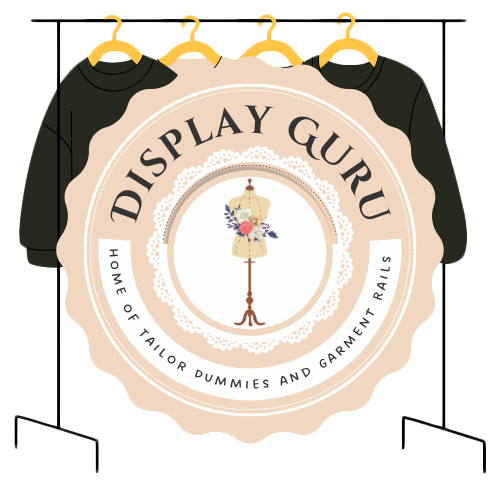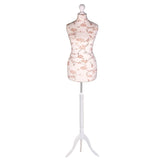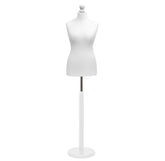Choosing Hat Display Stands for Retail Success
Hat display stands are so much more than a place to hang your stock. They're vital visual merchandising tools that turn a simple product into something a customer truly desires. The right stand doesn't just show off your headwear; it communicates your brand's quality and can genuinely sway a shopper's decision to buy.
Why Your Hat Display Is More Than Just a Hook
Picture this: a cap hanging limply on a peg, versus the same cap presented on a sleek, well-lit mannequin head. The first is just an item. The second tells a story.
That’s the essence of effective visual merchandising. Your display becomes an active part of the sale, creating an environment that grabs attention, telegraphs quality, and helps shoppers imagine themselves wearing your products.
In a crowded retail space, your displays have to fight for attention. Think of them as your silent salespeople. They guide the customer's eye, highlight key features, and create a clean, professional look. A well-chosen hat display stand can make a budget-friendly beanie look premium or give a luxury fedora the spotlight it deserves. This kind of strategic presentation is a cornerstone of successful retail display stands.
Setting the Stage for Sales
The real goal here is to shift from just storing hats to actively selling them. A great hat display does three key things:
- Shapes Customer Perception: A minimalist metal stand whispers modern sophistication, while a rustic wooden one feels grounded in heritage and craftsmanship. The material and design instantly set a tone before a customer even touches the product.
- Tells a Brand Story: Grouping hats by collection, colour, or style on the right stands helps build a cohesive narrative. You can curate a "summer festival" vibe or a "classic city wear" look just through thoughtful arrangement.
- Drives Revenue: An engaging display invites people to interact. When a hat looks appealing and is easy to pick up, customers are far more likely to try it on—massively increasing the chance of a sale.
This potential is huge, especially in the UK's vibrant headwear market, which is fuelled by both high fashion and a massive sports culture. The market pulled in around USD 546.6 million back in 2022 and is expected to nearly double by 2030. You can get more details on the UK headwear market's growth over at grandviewresearch.com.
When you start treating your hat display stands as a critical part of your marketing and branding, you unlock their true potential. They don't just showcase products; they actively grow your business and build a loyal customer base.
Ultimately, every choice you make—from a simple T-stand to an elaborate wall system—shapes the shopping experience. Getting this foundational concept right is the first, most important step toward choosing the perfect stands for your unique needs.
Finding the Perfect Fit for Your Hats
Choosing the right hat display stands isn't just about finding a place to hang your stock. It's more like casting a film; each stand plays a specific role, highlighting a hat's best features and telling a story that connects with your customer. Stepping away from a one-size-fits-all mentality is your first move toward creating a truly captivating retail space.
The real goal is to present a hat in a way that resonates with the shopper, not just to hold it up. A luxurious fedora demands a different stage than a casual baseball cap, and your choice of stand is what sets that stage. Let’s walk through the main options and see where each one truly excels.
Hat Display Stand Comparison Guide
To get started, here's a quick reference guide that breaks down the most popular types of stands. It's a great way to see, at a glance, which option might be the best fit for your specific needs.
| Display Stand Type | Best For | Typical Location | Key Benefit |
|---|---|---|---|
| Mannequin Head | Styled hats (fedoras, fascinators, cloches) | Window displays, high-end shelving | Shows realistic fit and context |
| T-Stand | Single hero items, premium hats | Countertops, checkout areas, display cases | Elegant, minimalist focus on the product |
| Wall-Mounted Rack | Large volumes of similar hats (caps, beanies) | Feature walls, high-traffic corridors | Maximises space and creates visual impact |
| Cap Form | Structured hats, particularly baseball caps | Slatwall, shelving units, pegboards | Preserves the hat's intended shape |
This table helps narrow down the choices, but the real magic happens when you understand the "why" behind each selection. Let's delve a little deeper.
Mannequin Heads: The Realistic Storyteller
Mannequin heads are, without a doubt, the best way to show a customer how a hat will actually look and feel when worn. They immediately answer that all-important question: "How would that look on me?" This is absolutely critical for hats where the shape, drape, and overall silhouette are major selling points—think of elegant cloches, wide-brimmed sun hats, or delicate fascinators.
Beyond just function, they add a genuinely human touch to your display. A well-chosen mannequin can instantly set a mood, whether it's vintage glamour or modern chic, turning a simple product into an aspirational part of a lifestyle. For a deeper look at getting the most out of this powerful tool, have a read of our guide on the benefits of using a head mannequin stand.
T-Stands: The Elegant Minimalist
When you want the hat itself to do all the talking, a T-stand is your best friend. Its simple, clean lines draw the eye straight to the product without any fuss or distraction. These are absolutely perfect for countertops, till points, or for creating a spotlight on a particular piece within a larger collection.
Their minimalist design also makes them incredibly versatile. You can showcase anything from a classic trilby to a structured beret, and they always add a touch of class that works beautifully in boutique environments. By elevating the hat, a T-stand gives it a sense of importance, signalling to customers that this is a special, featured item.
This decision flowchart is a handy tool for thinking through your primary goal, whether it's to drive immediate sales or build a stronger brand identity.

As the chart illustrates, focusing your efforts on either direct sales or brand building will naturally lead you toward different, but equally effective, display solutions.
Wall-Mounted Racks: The Smart Space Saver
When your floor space is precious, wall-mounted racks are the ultimate problem-solvers. They empower you to transform empty walls into a vibrant, shoppable gallery of headwear. This approach is a lifesaver for retailers with a large inventory of similar styles, like sports caps or beanies, as it allows for merchandising a huge number of items in a small footprint.
Organising hats in neat rows lets you create a powerful visual statement through colour-blocking or grouping by style. Not only does this look fantastic, but it also makes it incredibly easy for customers to scan your entire range at a glance. Wall displays keep your products organised and accessible, cutting down on the clutter that can easily build up on tables.
A core principle of great merchandising is making it intuitive for the customer to browse. Wall racks nail this by presenting a clear, organised, and comprehensive view of your collection, inviting people to explore without feeling overwhelmed.
Cap Forms: The Shape Keeper
There's nothing worse than seeing a structured hat lose its form. Baseball caps, in particular, have a specific shape that needs to be maintained. Just throwing them on a standard hook or laying them on a flat surface can quickly leave them looking limp and unappealing. This is exactly where specialised cap forms come into play.
These displays are engineered to perfectly support the crown of a cap, making sure it always looks crisp, fresh, and ready to be worn. It’s a small detail that makes a massive difference in how customers perceive the quality of your products. Using cap forms shows you care about your merchandise, which builds trust and reinforces the value of what they're about to buy.
How Materials and Finishes Shape Your Brand Story
The material you choose for a hat display stand does far more than just hold a hat. It’s a silent storyteller, setting the stage for your brand long before a customer even touches the merchandise. The stand is the first handshake, and it can subtly influence how someone perceives the value, style, and quality of your headwear.
Think of it this way: a polished chrome stand is like a sharp, tailored suit—it speaks of modernity, precision, and a clean, urban aesthetic. A stand carved from natural wood, on the other hand, is more like a well-made wool jumper; it evokes warmth, authenticity, and a sense of tradition. Each material tells a completely different story.
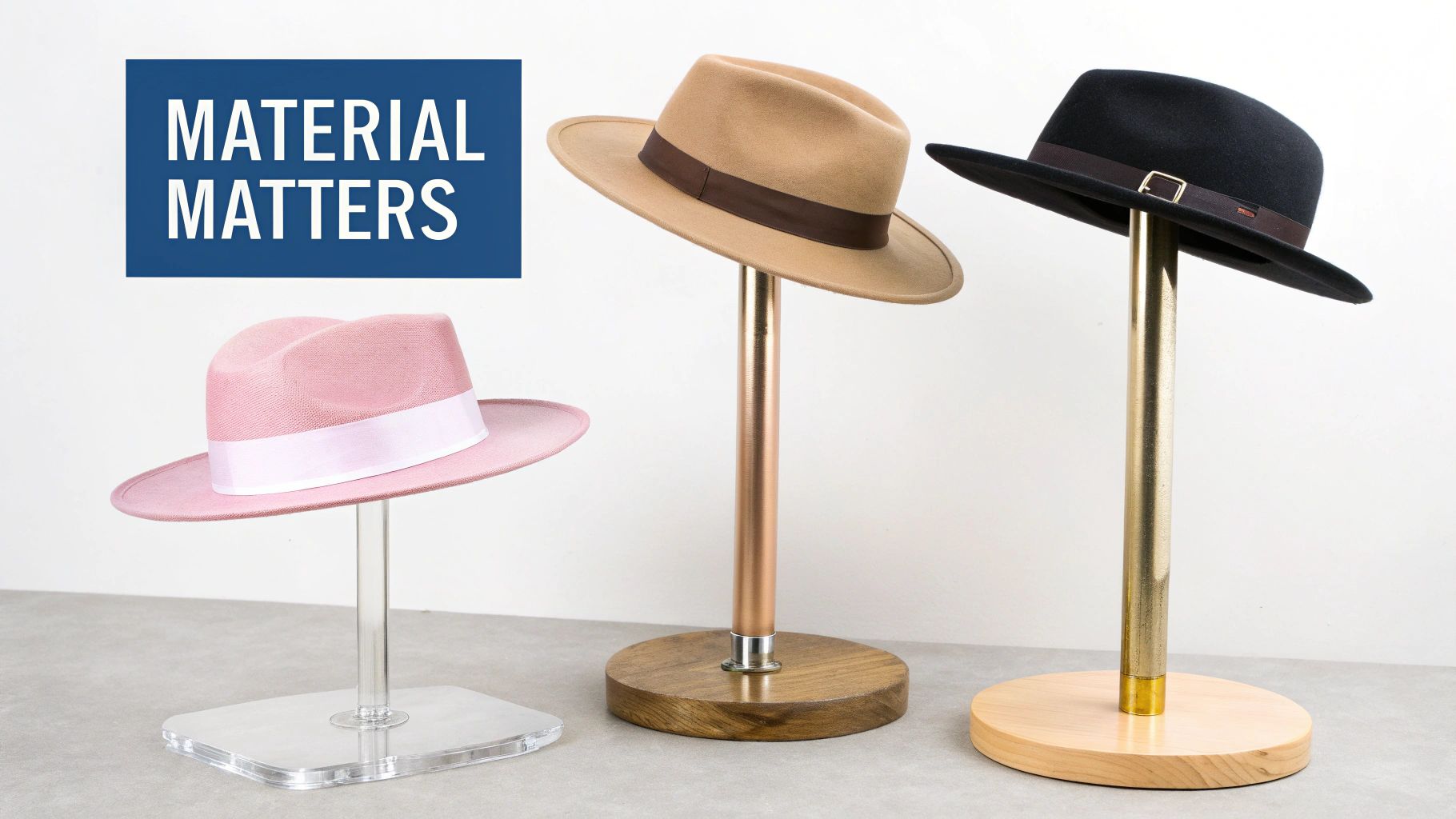
Matching Materials to Your Brand Identity
Getting the material right is all about aligning your displays with the message you want to send. A brand selling sleek, contemporary streetwear needs a very different look from a boutique that specialises in handmade, artisanal hats.
Here’s a quick rundown of how different materials can help define your shop's atmosphere:
- Metal (Chrome, Matte Black, Brass): Metal is a true chameleon. Polished chrome gives off a bright, modern vibe that’s perfect for sportswear or minimalist fashion. A matte black finish, however, instantly elevates the look, creating a sophisticated, high-end feel ideal for luxury hats where you want the product’s colour and texture to pop.
- Wood (Oak, Pine, Walnut): Nothing brings an organic, grounded element to a display quite like wood. Lighter woods like pine can create a casual, rustic or even Scandinavian feel. Darker woods, such as rich walnut, suggest heritage, craftsmanship, and quiet luxury. It's a natural fit for brands that champion timeless style.
- Acrylic (Clear, Frosted, Coloured): For the ultimate minimalist, clear acrylic is the answer. It creates a striking "floating" effect that makes the hat the undisputed star of the show. This works brilliantly for headwear with intricate details or vibrant colours, as it removes all visual distractions.
Your display material isn’t an afterthought; it’s a cornerstone of your visual merchandising. It should harmonise with your shop's décor, echo your brand's personality, and showcase your hats in a way that creates a truly seamless and memorable customer experience.
Finishes That Fine-Tune Your Message
Beyond the core material, the finish adds another crucial layer to your brand’s story. A glossy finish, for instance, reflects light and energy, creating a dynamic, eye-catching display. A matte finish does the opposite, absorbing light to lend a sense of understated elegance and sophistication.
Even combinations can make a statement. Pairing a wooden base with a metal upright, for example, creates a compelling blend of industrial and natural aesthetics that feels very current. In the UK, you’ll find that many retail settings lean towards durable steel with polished chrome finishes, especially on tiered floor stands with multi-positional arms that present headwear beautifully.
Experimenting with visual concepts before you invest can be incredibly helpful. Some retailers are even exploring AI-powered design tools to visualise how different material and finish combinations will look in their space.
Ultimately, every choice should be deliberate. If you’re displaying structured felt hats, a sturdy mannequin head is often the best way to maintain their shape and presence. For a bit more on that, you might find our guide on selecting the right stand for a mannequin useful. By carefully selecting your materials, you ensure every single display stand works hard to build a powerful brand identity that connects with every customer who walks through your door.
Tailoring Displays for Any Selling Environment
The perfect hat display isn't a one-size-fits-all solution; it has to feel right for its surroundings. A stand that shines in a bustling high-street shop might look completely out of place in an intimate design studio. Getting to grips with your specific environment is the secret to choosing hat display stands that not only look the part but also work hard for you.
This is about more than just the stand itself—it's about the customer's journey. How do people move through your space? What's their mindset when they walk in? Answering these questions helps you build a display strategy that feels completely natural for where you're selling.
The Bustling Retail Shop
In a busy retail environment, your displays are on the front line. The name of the game is durability, interaction, and visibility. Your hat displays need to be tough enough to handle constant attention from curious customers, yet eye-catching enough to stop them in their tracks. It’s a setting that demands a practical, compelling approach.
For a retail space, focus on these key features:
- Sturdy Construction: Go for metal or solid wood stands, ideally with weighted bases to prevent them from toppling over. In a busy shop, durability is non-negotiable.
- Interactive Design: Your displays should practically invite customers to touch and try on the hats. Wall racks and freestanding multi-tier stands that are easy to access are brilliant for this.
- Clear Organisation: Group your hats by style, colour, or collection. A well-organised display makes browsing feel intuitive and stops customers from feeling overwhelmed.
The cultural significance of hats in the UK has influenced everything from production to presentation, which in turn shapes the design of hat stands. This creates a real need for stands that can safely and attractively showcase different styles, from high-street shops to exhibitions, driving demand for solutions that are both beautiful and built to last.
The Creative Milliner Studio
A milliner’s studio or a bespoke atelier is a completely different world. It’s an intimate, consultative space where the display stand acts less as a sales tool and more as a sophisticated piece of theatre. It has to reflect the artistry and craftsmanship of the hats it holds.
Here, your displays serve a dual purpose: they need to impress clients during consultations while also doubling as elegant storage. The focus shifts from sheer durability to refinement and aesthetic harmony.
In a creative studio, each hat display stand becomes part of the decor. It should feel like a carefully chosen piece of furniture that complements the creative atmosphere and highlights the unique quality of each handmade piece.
Think about bringing in:
- Elegant Mannequin Heads: Fabric-covered or minimalist abstract heads present bespoke creations with the grace they deserve, showing clients exactly how a piece will sit.
- Minimalist T-Stands: A single, beautifully crafted T-stand can elevate a hero piece, giving it the spotlight it needs during a client viewing.
- Integrated Storage Solutions: Your displays can be part of custom shelving or cabinetry, creating a seamless look that is both beautiful and functional for storing delicate materials.
Keeping an eye on broader retail strategies, like the latest omnichannel retail examples, can also give you fresh ideas for blending the physical and digital experience, even in a bespoke studio.
The Dynamic Event Space
Markets, trade shows, and pop-up events come with their own unique set of challenges. In these temporary, often crowded settings, your displays must be portable, quick to assemble, and able to make an immediate visual impact. Your goal is to grab attention fast and leave a lasting impression in a very short amount of time.
Portability and ease of assembly are everything. You need stands that are lightweight but stable, and that pack down easily for transport without sacrificing a professional look. For more expert advice on making a strong impression at temporary venues, take a look at our guide to display ideas for craft fairs. In a competitive market environment, a great setup can make all the difference.
Arranging Your Displays to Guide and Engage
Owning the perfect hat display stands is a brilliant start, but their real magic is unlocked in how you arrange them. A thoughtful layout can turn a simple collection of products into an engaging visual journey, guiding your customer's eye and making your headwear look irresistible. This is the art of visual merchandising, and it's what turns browsers into buyers.
Strategic arrangement creates a deliberate flow—it's the difference between a cluttered table and a curated exhibit. When you move beyond just putting things out, you can build displays that tell compelling stories, spotlight your hero products, and create an atmosphere that feels both professional and inviting.
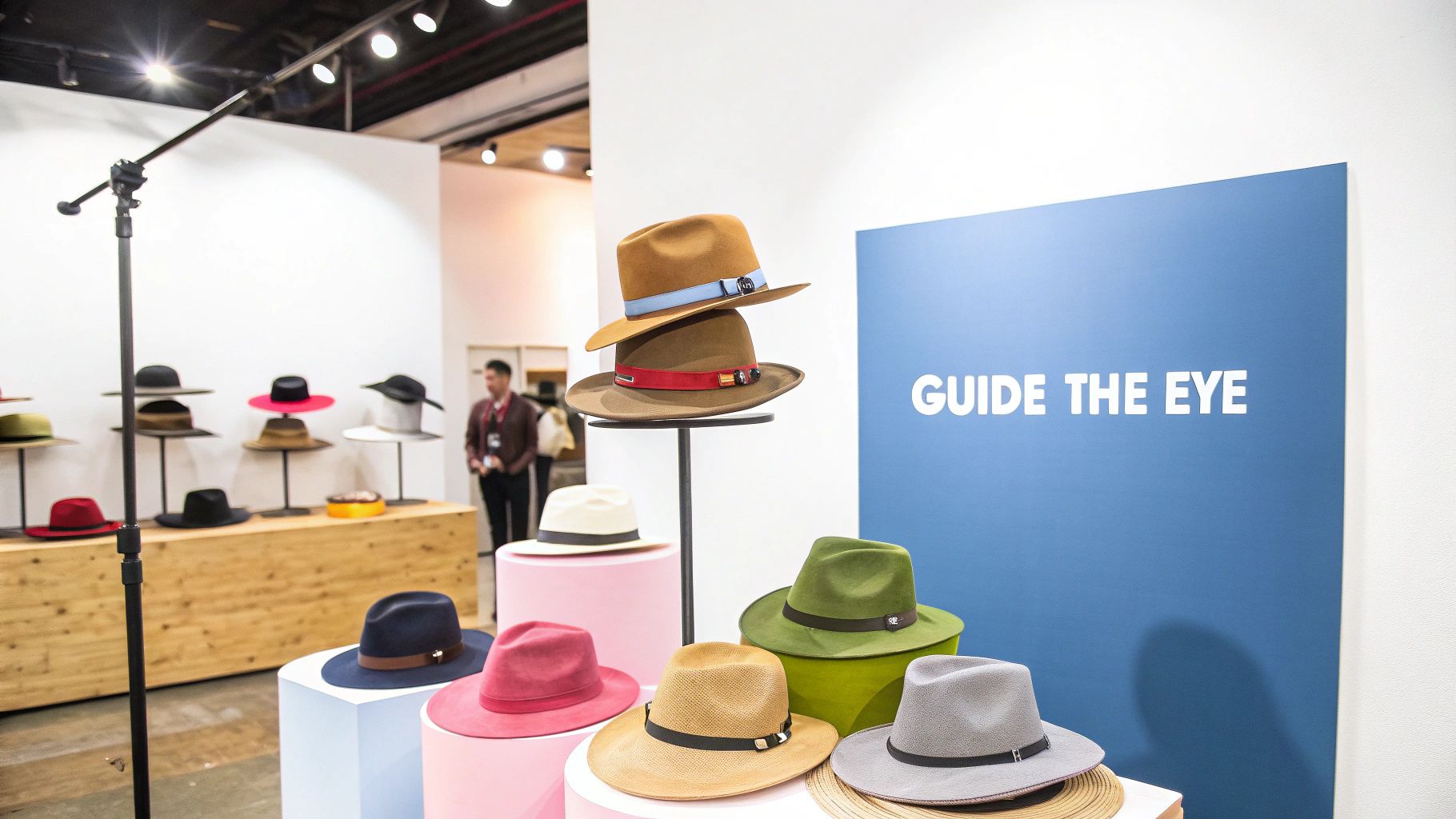
Create a Visual Journey with Varied Heights
One of the most powerful tricks in the merchandising playbook is playing with height. A display where every hat sits at the same level is visually flat and, frankly, a bit boring. It forces a customer’s eye to scan aimlessly from side to side without a clear place to land.
Instead, use a mix of stands—taller floor models, mid-level T-stands on tables, and shorter risers—to create peaks and valleys. This dynamic landscape naturally guides the viewer's gaze from one product to the next, encouraging them to take in the entire collection. Think of it as creating a visual rhythm that keeps people engaged and moving through your space.
Group Products to Tell a Story
Randomly placed hats only create confusion. The secret is to group your headwear with purpose, telling clear, easy-to-understand stories. This helps shoppers quickly find what they're looking for and might even introduce them to styles they hadn't considered.
Try these tried-and-tested grouping strategies:
- By Colour: Arrange hats to create stunning colour gradients or bold, monochromatic blocks. It’s a simple but incredibly effective way to achieve a clean, organised look that really pops.
- By Style: Keep all your fedoras in one section, your beanies in another, and your caps together. This practical approach makes life easier for customers who already know what style they want.
- By Collection or Theme: Build a display around a concept, like a "Summer Getaway" edit featuring sun hats and panamas, or a "City Chic" collection with elegant felt hats and berets. This inspires customers by showing them how your hats fit into a desirable lifestyle.
When you tell a story with your arrangement, you stop just selling an item and start selling an idea. For a deeper dive into these concepts, have a look at our complete visual merchandising guidelines for more expert tips.
Master the Rule of Three
The 'Rule of Three' is a classic design principle that works wonders in retail. It suggests that items arranged in odd numbers are more appealing and memorable to the human eye than items in even numbers. A cluster of three or five hats simply feels more natural and less staged than a pair or a block of four.
Put this rule into practice on your feature displays. On a central table, for instance, try arranging three mannequin heads at slightly different heights and angles. This simple tweak creates a more dynamic, balanced composition that naturally draws attention.
Good visual merchandising isn't about filling every inch of space. It's about making deliberate choices. The empty space around your displays is just as important as the displays themselves—it gives your products room to breathe and stand out.
This concept, known as negative space, is absolutely crucial for avoiding a cluttered, overwhelming look. It creates focal points and gives your display a more premium, considered feel. So don't be afraid to leave some surfaces clear; that intentional emptiness makes the items you do display feel that much more special.
Looking After Your Display Investment
Your hat display stands are more than just bits of shop kit; they're a core part of your brand's presentation. Think of them as a valuable asset. Keeping them in top nick isn't just about being tidy—it's about protecting that investment so your displays look sharp and do their job for years to come. A well-maintained stand quietly tells customers you care about quality.
This is particularly true when you’re working with different materials. Each one needs a slightly different touch to stay looking its best. A one-size-fits-all approach to cleaning just won't cut it and could even cause damage over time.
Material-Specific Care Tips
Every material responds differently to cleaning agents and methods. Using the wrong technique can easily lead to scratches, a dull finish, or even permanent damage.
Here’s a quick rundown on how to care for the most common materials to keep them in mint condition:
- Polishing Chrome: To keep that bright, mirror-like shine without scratching the surface, always reach for a soft, microfibre cloth. For stubborn fingerprints or smudges, a little bit of mild soap and warm water does the trick. Steer clear of any abrasive cleaners – they’ll strip the shine for good.
- Dusting Fabric Forms: Fabric-covered mannequin heads and cap forms are magnets for dust. A quick once-over with a lint roller or the soft brush attachment on your vacuum (on its lowest setting) will lift away any debris. If you spot a small mark, you can try dabbing it with a slightly damp cloth, but always test it on a hidden spot first.
- Maintaining Acrylic: The secret to keeping acrylic stands crystal clear is to avoid ammonia-based products, like most household window sprays, as they can cause the material to go cloudy. All you need is a soft cloth with a touch of soapy water, then dry it with a separate clean cloth. This simple step prevents scratches and preserves that transparent look.
The best strategy is to make it a routine. A quick wipe-down at the end of the week is far easier than trying to tackle months of built-up dust and grime. It’s a simple habit that ensures your displays always look brand new.
Smart Storage for Lasting Quality
Storing your stands correctly is just as important as cleaning them. This is especially true if you run a pop-up shop, attend markets, or change your displays seasonally. Proper storage prevents chips, dents, and other damage, meaning they’re always ready to go when you need them. When it’s time to pack things away, don't just shove them in a back room.
Instead, take a moment to do it right. If the stands can be disassembled, take them apart. Wrap each piece individually in bubble wrap or soft fabric to create a protective cushion. A quick label on each wrapped part will save you a headache when it's time to put them back together. Store everything in sturdy, clearly marked boxes, putting the heavier bits at the bottom so they don’t crush the more fragile parts. A little organisation here goes a long way in keeping your stands looking perfect for every single use.
Your Questions About Hat Displays Answered
It's one thing to have a plan on paper, but when you start setting up your shop fittings, the real-world questions always emerge. We get asked a lot about the practical side of choosing and using hat display stands, so I’ve pulled together the most common queries from retailers and designers just like you. Here are some quick, clear answers to help you get it right.
Which Stand Works Best for Different Hat Styles?
This is the big one. Matching the stand to the hat is the secret to a great presentation, because the right stand does all the work for you. It really comes down to the hat's structure.
For anything soft and unstructured, like beanies or slouchy hats, you can't go wrong with a simple dome-style stand or a minimalist T-stand. Their job is to give the hat just enough shape to look appealing without distorting or stretching the delicate fabric.
But for structured hats—think fedoras, trilbies, or cloches—you need to give them proper support. This is where a mannequin head is your best friend. It preserves the hat's intended shape perfectly, from the crown to the brim, showing customers exactly how it will sit. And for baseball caps? A dedicated cap form is a must-have to keep that classic curved silhouette looking sharp.
A good rule of thumb: if the hat has a defined shape you need to protect, use a stand that mimics the human head. If it's soft and malleable, a simpler form will do the job beautifully.
How Do I Clean and Maintain My Stands?
Keeping your displays looking fresh and professional is all about a little routine maintenance. How you clean them really just depends on the material.
- Acrylic Stands: A soft microfibre cloth and a touch of soapy water are all you need. The most important thing here is to avoid ammonia-based cleaners, like many window sprays. They can cause the acrylic to go cloudy over time, which you definitely don't want.
- Metal Stands: For chrome or powder-coated metal, a quick wipe with a damp cloth is usually enough to handle dust and fingerprints. If they need a bit more of a polish, a mild, non-abrasive cleaner will bring back the shine without leaving any scratches.
A regular, gentle clean stops dust and grime from building up, ensuring your hats are always shown in the best possible light.
How Can I Make My Floor Displays More Stable?
There's nothing worse than a wobbly display in a busy shop; it’s a genuine hazard. The first thing to check is that you're on a level surface. If the floor itself is a bit uneven, you can slide small, discreet shims under the base to stop any rocking.
For real peace of mind, especially with taller units, look for stands that come with a weighted base. They’re designed specifically for high-traffic areas and are far more difficult to topple. If you're working with lighter stands you already own, you can add your own weights. Sandbags or custom weights can be placed on the base, often hidden with a decorative cover or tucked away behind the unit. Just be sure whatever you add is secure and doesn't create a new trip hazard.
Where Should I Place Wall-Mounted Displays?
Positioning is everything for wall-mounted displays. You want them right in your customer's natural line of sight. A great general rule is to place the centre of the display at average eye level, which is typically between 1.5 and 1.7 metres (around 5 to 5.5 feet) from the floor.
This height makes it effortless for people to see all the details of each hat without having to look up or bend down. It also naturally invites them to reach out and touch the product. If you're creating a larger feature wall with several rows of hats, use that eye-level measurement as your central anchor and build your arrangement up and down from there.
At Display Guru, we offer the professional-grade stands and mannequins you need to build stunning and effective headwear displays. Explore our complete collection and find the perfect solutions for your retail space.
